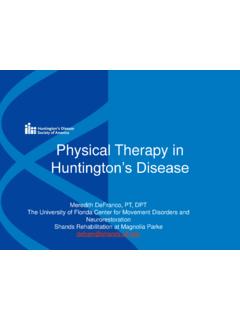Transcription of Genetic testing for Huntington’s Disease
1 1 Genetic testing PROTOCOL FOR huntington S Disease You can obtain a copy of the Genetic testing Protocol for huntington s Disease by emailing HDSA at 2016 huntington s Disease Society of America All rights reserved.
2 Printed in the United States of America. 2 FOREWORD Since the advent of Genetic testing for huntington s Disease , the huntington s Disease Society of America (HDSA) has played a key role in establishing guidelines for safe and effective testing . As recent advances in both basic and clinical research lead to the promise of new opportunities for treatment and care, HDSA has revisited these guidelines to ensure that they continue to reflect best practices for both diagnostic and predictive testing . This document was written by HDSA with input from clinicians, laboratory professionals, and individuals at risk for HD to provide guidance for Genetic testing for huntington s Disease (HD).
3 In 1983, huntington s Disease became the first Disease to be mapped to a previously unknown Genetic location on chromosome 4. Over the past 30 years, Genetic testing for huntington s Disease has progressed from the identification of linked Genetic markers to the development of direct Genetic testing . Throughout that history, groups such as the huntington s Disease Society of America, the International huntington s Association, and the World Federation of Neurology have provided recommendations for testing to health professionals wishing to provide such testing , as well as to individuals affected and at risk for HD who wish to pursue testing .
4 While technological advances have made Genetic testing for HD faster, cheaper, and more accurate, predictive testing for HD remains a process with the potential to have profound implications for the life of an individual who chooses to be tested. So while we favor eliminating barriers to testing to the extent possible and maintaining flexibility in the way that testing is offered, experience has shown that the following elements are essential to the testing process: pretest counseling, informed consent and in-person results. A child should not be tested unless the child is exhibiting symptoms that cannot be attributed to any other condition.
5 HDSA hopes that this publication will be useful to those working with people with huntington s Disease and their families, as well as the families themselves. 3 TABLE OF CONTENTS PREFACE .. 4 SECTION 1 .. 5 Introduction Historical Background Direct Gene Test Clinical Uses of the Gene Test SECTION 2 .. 8 Predictive testing SECTION 3 .. 13 Confirmatory testing SECTION 4 .. 14 Prenatal testing SECTION 5 .. 16 testing of Minors Anonymous testing testing Two People with One Test Results of Intermediate Alleles SECTION 6 .. 18 Conclusions SECTION 19 References SECTION 20 Acknowledgements 4 PREFACE This protocol has been produced by the huntington s Disease Society of America to assist Genetic counselors and other healthcare professionals involved in the Genetic testing process for huntington s Disease and to protect the well-being of individuals who choose to be tested.
6 The protocol is a framework of recommended procedures for testing ; they are not regulations. Each provider, center, or institution that offers Genetic testing for HD and each testing situation is unique. Providers must ensure that testing is performed safely despite variations among patients, personnel, and geography. The huntington s Disease Society of America is particularly concerned about Genetic predictive testing -- testing in asymptomatic individuals. HDSA maintains a list of centers where predictive testing protocols appear to meet the best practices described within.
7 For more information on this list, please contact HDSA at HDSA first published Guidelines for Predictive testing for huntington s Disease in 1989. A revision entitled Genetic testing for huntington s Disease was published in 1994 and revised in 2003. The current document reflects over two decades of experience with Genetic testing for HD and is based on a review of the previous HDSA guidelines, the experiences of many who have been tested or who offer the tests, and the growing body of knowledge about Genetic testing for many other diseases. 5 SECTION 1 INTRODUCTION huntington s Disease (HD) is a hereditary neurodegenerative disorder.
8 The HD gene is present from the time of conception and is inherited in an autosomal dominant fashion, meaning that each child of an affected parent, regardless of gender, has a 50% chance of inheriting the Disease -causing gene. The prevalence of HD is estimated at 1/10,000 individuals in the United States; thus, the population to whom Genetic testing might be applied includes approximately 30,000 affected individuals and 200,000 at-risk individuals. The typical onset of HD symptoms is between ages 30-50. However, onset of symptoms has been seen in children under 5 years of age or as old as 90 years.
9 There is an inverse relationship between the size of the pathogenic variant (CAG repeat expansion) and the age of symptom onset, in general, larger gene expansions are associated with earlier onset ages, although other factors may also influence the age of onset. Occasionally, individuals with a lower CAG repeat expansion may live up to or beyond a normal lifespan without developing symptoms. However, except for these unusual cases, the presence of an HD gene with a CAG repeat expansion is always associated with the development of HD symptoms The early symptoms of HD vary and may be subtle enough to go undetected.
10 These symptoms may include behavioral changes such as depression and mood swings, minor twitching, fidgeting, clumsiness, changes in gait, and lapses in judgment and memory. Symptom progression is likewise extremely variable. As the Disease progresses, involuntary movements, particularly chorea, may become more pronounced. Speech and swallowing difficulties often develop and cognitive ability deteriorates. In the later stages of the Disease , the affected individual is usually bedridden and totally dependent on others for all of his or her needs. The duration of symptoms may range from 10 to 25 years or more.











